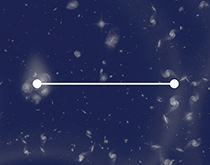A young woman visits Santa Fe, N.M., for a conference and sees the Milky Way for the first time. City lights and smog—in Hong Kong where she was born and California where she has recently lived—haven’t allowed her a naked-eye view. Faced with a beauty only clarity can bring, she feels a “togetherness with those far-away stars” and decides on a career in cosmology.
 Around the same time, in 1998, she admires astronomers and their “standard candle” supernova discovery. The standard brightness from bursting stars enables astronomers to measure the stars’ distances, which can prove that the universe is expanding faster than the laws of physics were thought to allow. This discovery requires a look outside the galaxy because, like the city sky, the Milky Way is too bright.
Around the same time, in 1998, she admires astronomers and their “standard candle” supernova discovery. The standard brightness from bursting stars enables astronomers to measure the stars’ distances, which can prove that the universe is expanding faster than the laws of physics were thought to allow. This discovery requires a look outside the galaxy because, like the city sky, the Milky Way is too bright.
Now that young woman, Shirley Ho, is an assistant professor of physics at Carnegie Mellon, a member of the Sloan Digital Sky Survey III’s BOSS collaboration, and a member of the McWilliams Center. She and her teams have found their own standard measurement approach. She focuses on baryonic acoustic oscillations in deep space—Big Bang effects like ripples from a pebble dropped in a pond. A “frozen ripple” imprint can be observed, from a time when the universe cooled, in every single galaxy.
“We use that measurement to chart most precisely the distance away from us,” she says. The research, though it may sound esoteric, could make our GPS systems more accurate, help us understand fusion for new energy possibilities, and even get us closer to answering: “Why are we here?”—a question that has intrigued Ho since she was that stargazer.
For her research, she’s won the 2014 Outstanding Young Researcher Award from the International Organization of Chinese Physicists and Astronomers, whose members include Nobel laureates and members of the National Academy.
—Jen Bannan (DC’91)



